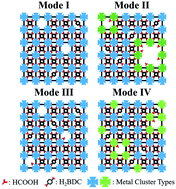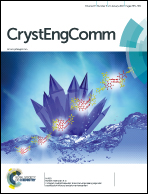Crystallization process development of metal–organic frameworks by linking secondary building units, lattice nucleation and luminescence: insight into reproducibility
Abstract
The interdependence of crystallinity, secondary building unit (SBU) formation, linker vacancy, crystal habit, photoluminescence, and surface area for UiO-66 and In-MIL-68, respectively, produced by different processing modes has been fully investigated and linked together to comprehend the relationships among SBU synthesis pathways, structures, and functional properties. The solid-state properties of UiO-66 were found to be process-sensitive, but those of In-MIL-68 except for crystal habits were mode independent, most likely due to the versatile Zr6(μ3-O)4(μ3-OH)4(CO2)12 SBU formation steps with more competing events for UiO-66 and the relatively straightforward {In(μ-O2CR)2(μ-OH)}∞ chain SBU formation steps for In-MIL-68. The reproducibility of the desired properties of metal–organic frameworks (MOFs) relies on the crystallization process designed for specific SBU formation and nucleation trajectory.



 Please wait while we load your content...
Please wait while we load your content...